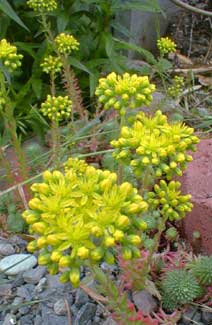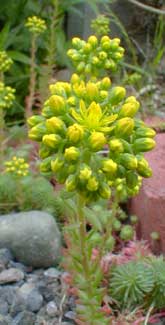
Reflexed Evergreen Sedum;
aka, Crooked Yellow Stonecrop;
aka, Love Links
"The yellow stone-crop suffered to take root
Along the window's edge, profusely grew,
Blinding the lower panes."
-William Wordsworth
Many little groundcover sedums get very scruffy or even vanish during winter, but this one I selected during the height of winter, seeing it among many other potted varieties, the others showing various degrees of winter damage, worn appearance, thinning, or dieback.
Compared to most of the others, this European native Sedum rupestre (synonymous with S. reflexum & sometimes offered as S. altissimum) was in fine fettle, as is evident by the February portrait showing the "most" winter injury it ever manifests, which is next to none. It is never frost-damaged in zones seven or eight. It should thrive down to zone 5 though not with quite such winter perfection.
 The dense succulent foliage is green to blue-green throughought the year, with reddish hues in winter, & having a general look of thick short conifer needles. A more strongly blue-green variant S. rupestra glauca is sold as 'Blue Spruce' because of the conifer-like appearance of the leaves.
The dense succulent foliage is green to blue-green throughought the year, with reddish hues in winter, & having a general look of thick short conifer needles. A more strongly blue-green variant S. rupestra glauca is sold as 'Blue Spruce' because of the conifer-like appearance of the leaves.It will thrive in poor, dry areas, & likes sandy soils. It needs sharp drainage if placed in any well-watered location, but is not prone to rotting even in wetter areas just so long as the soil is well aerated & not boggy. It tolerates considerable shade, but prefers full sun. During the hottest days of summer it may die back if not watered at all, but with a little water during lengthy dry periods it will be evergreen for all seasons.
As the species name rupestre indicates, its preferred habitat is among rocks, hence one of its common names is Rocky Stonecrop. A British name for it is "St. Vincent's Rock Sedum" or "Stonecrop of St. Vincent" because it long ago naturalized in Bristol over the cliffs of St. Vincent's Rock. The cliffs are believed to have gained the name in medieval times when monks dwelt in cells in the cliffs. It would have provided a rough food for such religious hermits. Though not originally native to the British Isles, it is now very common throughout the UK, likely having been brought to the continent by monks who grew it as a comestible.
 Several sedums are associated with love, marriage, & fertility. S. rupestris has been known as "Love Links," S. anglicum is known as "Love's Triangle," S. dasyphyllum is "Love & Tangles," & S. telephium has been called "Midsummer's Men." The latter name alludes to a tradition of young men taking two sedum leaves on Midsummer's Eve & laying them side by side to test compatibility with their future wives. If the two leaves roll away from one another, the marriage will not last; if they roll toward one another, the couple will live long together, for which reason S. telephium is even better known as "Live-Long."
Several sedums are associated with love, marriage, & fertility. S. rupestris has been known as "Love Links," S. anglicum is known as "Love's Triangle," S. dasyphyllum is "Love & Tangles," & S. telephium has been called "Midsummer's Men." The latter name alludes to a tradition of young men taking two sedum leaves on Midsummer's Eve & laying them side by side to test compatibility with their future wives. If the two leaves roll away from one another, the marriage will not last; if they roll toward one another, the couple will live long together, for which reason S. telephium is even better known as "Live-Long."The association with love & marriage is shared with sempervirons believed to enhance the fertility of women & the sexual potency of men, so that many love-spells & filtres involved the use of stonecrops or hens & chicks. This isn't actually likely, as some sedums have phytoestrogens that could lower male infertility, but it's not inconceivable it also retarded male aggression & so indeed made couples more compatible in mood.
There was an associated belief that if evergreen succulents died either in the heat of summer or wetness & cold of winter, this meant the health of a household, or the success of a marriage, was at risk; if it kept its evergreen presence year-round, the household would experience continuous compatibility & good luck.
S. rupestre has naturalized in many places of the world, including as a garden escapee in various places of the American East coast & lower Great Lakes states.
We planted ours in two locations. The patch shown on this page is in a tough roadside area in the alley, & has nothing nearby it might overwhelm. Every couple years the town drives a plow down the alley to evenly disperse gravel, inevitably covering up part of the stonecrop, but it bounces back so quickly it's almost like it enjoyed the abuse.
When adding it to rockeries one must be careful of its companions, as it will displace other sedums of the same size or smaller. Our second patch is in a harsh area on the curbside of the road, where it's nearest groundcover companion is succulent Ice Plant, one of the most aggressive of all xeriscape succulents. I'm still observing this pairing to find out if they can cohabit over a long length of time; my thinking is that S. rupestra will prove itself one of the few sedums to really hold its own next to swiftly-spreading Ice Plant, but time will tell; perhaps even this sedum will be overtaken.
It can drape down stone walls very prettily, or over the sides of containers. It's a good choice to plant around the rootcrown of clematis or other plants that like to be in full sun but nevertheless require their roots to be protected from exposure to direct sun. Tall-flowering tulips & narcissi or lilies can be layered beneath it, as the sedum is not deeply rooted, & bulbs will send up their leaves & flowers well above the level of the stonecrop, sharing an area very comfortably.
Yellow flowers occur in tight racemes on stems June through August, as shown in the second photo snapped in June. These have lent it the occasional common name Goldmoss & more often Yellow Stonecrop. A variety discovered in Croatia & marketed as 'Angelin'" even has leaves that are yellow. Also alluding to the yellow flowers is the common name "Stone Orpine" used also for other sedums including ones with flowers of other colors, it having been forgotten that the name originally alluded to orpiment, a mineral from which a yellow dye is made.
I've never encountered an explanation for why Reflexed Sedum is sometimes called "Jenny's Stonecrop," but if I were to take a guess, it would be in homage to "the Swedish nightingale," Jenny Lind (1820-1887), who by the 1850s had sparked what was internationally referred to as "Lindomania," so very long before the coinage "Beatlemania." But I suppose it could also mean that someone's jenny, or female jackass, liked to graze it.
Yellow Stonecrop is elsetimes known as Blue Stonecrop because the leaves are usually blue-green. Another name alluding to the leaves is Tripmadam, sometimes Prickmadam, which are English, Dutch, or German corruptions of the French Trique-madame, literally "Three-sided Lady" or "Mrs. Three-sides."
These blue-green leaves are edible raw or cooked. The taste is acrid & pleasingly crunchy when eaten raw in a mixed salad. If a huge amount were eaten raw, they might cause mild stomach upset, which as a generality is said of all yellow-flowering sedums.
They are much milder when included in a stew. Or, to make a fabulous hotdog or sandwich relish (for tofu hotdogs or gardenburgers in our vegetarian household), mix separated sedum leaves with slivers of sweet bell peppers & onions to fry at a high heat in olive oil until the onions are browned & the bell peppers nearly transluscent, add some freshly grated black pepper, then refrigerate for use as a needed.